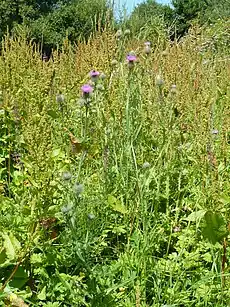Didea fasciata
Didea fasciata is a Holarctic species of hoverfly.[1][2][3]
| Didea fasciata | |
|---|---|
 | |
| Didea fasciata male | |
| Scientific classification | |
| Domain: | Eukaryota |
| Kingdom: | Animalia |
| Phylum: | Arthropoda |
| Class: | Insecta |
| Order: | Diptera |
| Family: | Syrphidae |
| Genus: | Didea |
| Species: | D. fasciata |
| Binomial name | |
| Didea fasciata Macquart, 1834 | |

Description
External images
For terms see Morphology of Diptera
Wing length 8·25– 11 mm. Halteres with yellow knob. Face yellow, at most the tip of the central knob dark.[4][5]
[6][7] The male genitalia are figured by Vockeroth (1969).[8] The Larva is described and figured by Heiss (1938) .[9]
Distribution
Palaearctic and Nearctic. Fennoscandia South to Spain; Italy and Greece. Ireland eastwards through Russia and the Russian Far East to the Pacific coast. North America from British Columbia South to New Mexico and East to New York. Oriental region to North India and Formosa[10][11][12]

Biology
Habitat: Deciduous and coniferous forest, tracksides, clearings.[13] Flowers visited include white umbellifers, Arbutus unedo, Chaerophyllum, Crataegus, Galium, Hedera, Hypochoeris, Polygonum cuspidatum, Rubus fruticosus, Rubus idaeus, Sambucus, Urtica dioica, Viburnum opulus.[14] The flight period is May to September. The aphid feeding larvae are arboreal, on both conifers and deciduous trees.
References
- Ball, S.G.; Morris, R.K.A. (2000). Provisional atlas of British hoverflies (Diptera, Syrphidae). Monks Wood, UK: Biological Record Centre. pp. 167 pages. ISBN 1-870393-54-6.
- Morris, Roger K. A. (1999). Hoverflies of Surrey. Surrey Wildlife Trust. p. 244. ISBN 0-9526065-3-4.
- Stubbs, Alan E.; Falk, Steven J. (1983). British Hoverflies: An Illustrated Identification Guide. British Entomological & Natural History Society. p. 253, xvpp.
- Van Veen, M. (2004) Hoverflies of Northwest Europe: identification keys to the Syrphidae. 256pp. KNNV Publishing, Utrecht.addendum
- Van der Goot,V.S. (1981) De zweefvliegen van Noordwest - Europa en Europees Rusland, in het bijzonder van de Benelux. KNNV, Uitgave no.32: 275pp. Amsterdam.
- Bei-Bienko, G.Y. & Steyskal, G.C. (1988) Keys to the Insects of the European Part of the USSR, Volume V: Diptera and Siphonaptera, Part I. Amerind Publishing Co., New Delhi. ISBN 81-205-0080-6.
- Coe, R.L. (1953) Diptera: Syrphidae. Handbks.ident.Br.insects, 10(1): 1-98. R.ent.Soc.London. pdf Archived 2018-10-04 at the Wayback Machine
- Vockeroth J.R. (1969) A revision of the genera of the Syrphini (Diptera: Syrphidae).Memoirs of the Entomological Society of Canada 62: 1 –176.
- Heiss, E.M. (1938) A classification of the larvae and puparia of the Syrphidae of Illinois exclusive of aquatic forms. Univ.Illinois Bull. , 36: 1-142.
- Fauna Europaea
- Peck, L.V. (1988) Syrphidae. In: Soos, A. & Papp, L. (eds.) Catalogue of Palaearctic Diptera, 8: 11-230. Akad.Kiado, Budapest.
- Vockeroth, J. R. (1992). The Flower Flies of the Subfamily Syrphinae of Canada, Alaska, and Greenland (Diptera: Syrphidae). Part 18. The Insects and Arachnids of Canada. Ottawa, Ontario: Canadian Government Pub Centre. pp. 1–456.
- Speight, M.C.D. (2011). "Species accounts of European Syrphidae (Diptera)" (PDF). Syrph the Net, the database of European Syrphidae. 65: 285pp.
- de Buck, N. (1990) Bloembezoek en bestuivingsecologie van Zweefvliegen (Diptera, Syrphidae) in het bijzonder voor België. Doc.Trav. IRSNB, no.60, 1-167.